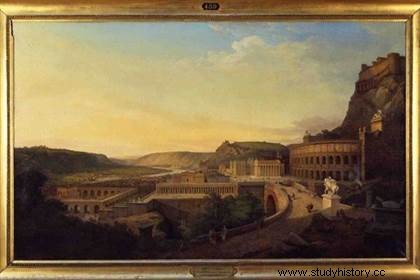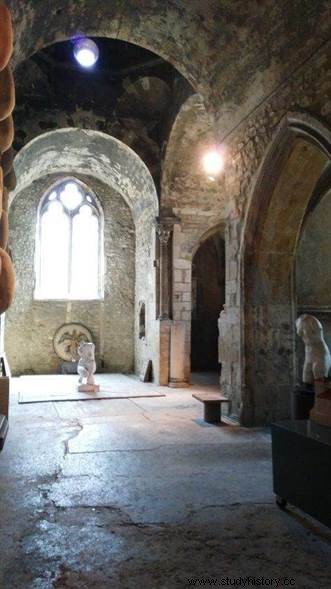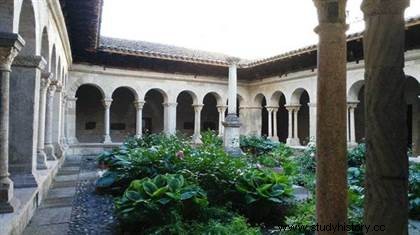 The City of Vienna conceals a rich historical heritage, its location, at the confluence of the Rhône and the Gère, at the convergence of the axes of circulation between the Alps and the central massif, and its hilly topography offering promontories, have made it a place of human settlement. from protohistory. The city now has around forty monuments or classified sites. Non-exhaustive overview of Vienna's heritage.
The City of Vienna conceals a rich historical heritage, its location, at the confluence of the Rhône and the Gère, at the convergence of the axes of circulation between the Alps and the central massif, and its hilly topography offering promontories, have made it a place of human settlement. from protohistory. The city now has around forty monuments or classified sites. Non-exhaustive overview of Vienna's heritage.
Gallo-Roman Vienna
Vienna features various ancient remains. The establishment of a Roman colony in Vienne remains poorly known, currently it is attributed to the reign of Octave Augustus (27 BC-14 AD).
On the site of the archaeological garden of Cybèle, which is located on the old Viennese hospital, remains of the Gallo-Roman city have been unearthed. see the arcades of the portico that bordered the forum, the remains of an assembly hall, as well as those of houses and furnished terraces. As far as housing is concerned, the site of Saint-Romain-en-Gal, located near Vienne, also retains the remains of a residential district.
 The Temple of Augustus and Livia, which at the time stood on the forum, is a building built for the cult of the Emperor Octave Augustus and of Rome (the homeland). Built between 20 and 10 BC. JC, the temple is peripteral sine postico (colonnade on three sides, that of the bottom being blind), hexastyle (six columns in front), with a Corinthian style decoration. In early Christian times the portico was closed and the temple converted into a church, which has allowed it to be preserved until today. It is often compared to the Maison Carrée in Nîmes.
The Temple of Augustus and Livia, which at the time stood on the forum, is a building built for the cult of the Emperor Octave Augustus and of Rome (the homeland). Built between 20 and 10 BC. JC, the temple is peripteral sine postico (colonnade on three sides, that of the bottom being blind), hexastyle (six columns in front), with a Corinthian style decoration. In early Christian times the portico was closed and the temple converted into a church, which has allowed it to be preserved until today. It is often compared to the Maison Carrée in Nîmes.
On the sides of Mont Pipet unfolds the theatre, built in the 1st century, it is one of the largest known Roman theatres. The building could accommodate more than 10,000 spectators.
On the Cours Brillier remains of the remains of the Roman enclosure, it is an enclosure more than 7 km long, the longest known in Gaul, built in the 1st century to surround the primitive city. Its area also makes it one of the largest Gallo-Roman towns in the provinces. This wall has an "honorary" value more than defensive, its construction is authorized by an imperial privilege, a sign of the prestige of the city.
Finally, in the garden of May 8, 1945, a Roman road was found and preserved, we can see there the ancient paving in granite blocks and a road marker (anachronistic, it dates from the reign of Constantine). Also in the park is a stone statue of a young man riding a lion, a medieval remnant of the monastery of Saint Peter. At the foot of the bell tower of the Saint Pierre church are two other statues of lions. According to a legend, all three were “miraculously” transported from Rome to Vienna in the 6th century. The three sculptures would then have served as "lanterns of the dead" in the abbey cemetery.
Medieval remains
 From the beginning of the Middle Ages, Vienne stood out as one of the cradles of Christianity in France, and became an important city. Various religious foundations were established there, and from the 11th century it was controlled by the bishops of the city.
From the beginning of the Middle Ages, Vienne stood out as one of the cradles of Christianity in France, and became an important city. Various religious foundations were established there, and from the 11th century it was controlled by the bishops of the city.
Saint Pierre Church, which now houses the lapidary museum, is one of the oldest churches in France, built in the 5th century, it is also the best preserved . Originally it was a funerary basilica where the bishops of Vienne are buried, such as Mamert, its probable founder. The apse and the wall arcades of the nave seem to belong to the primitive church. Alterations were carried out at the level of the windows in the Carolingian period, then in the 12th – 13th century, when the nave was divided into three naves, and the bell tower-porch added.
The collections now housed in the church include the sarcophagus of Saint-Léonien, a hermit who died in the 6th century. This white marble sarcophagus presents motifs of vine scrolls and a cantharus (handled vase), symbolizing the blood of Christ, as well as peacocks, which are associated with immortality for their reputedly rot-proof pulpit. In short, it is an iconography that symbolizes the resurrection.
Saint Maurice Cathedral has occupied the same location since the 4th century, but the current building is no earlier than the 10th century. Its monumental Gothic-style façade is pierced by three portals and flanked by two towers on either side.
 The cloister of the Abbey of Saint-André-le-Bas (founded in the 6th-7th century) is the only complete medieval cloister in the Rhône-Alpes region. Built in the 12th century, it was restored in the 1930s, then more recently from 2010 to 2011. Its style is typical of Rhone Romanesque art. The columns, of Corinthian inspiration, are decorated with plant motifs, works, or pearls. A capital in particular is decorated with the scene of Samson tearing the lion's mouth, a biblical theme from the Old Testament. The ceiling is not vaulted but wooden, coffered and painted. In one of the galleries of the cloister, columns from the bell tower of the Saint-André-le-Bas church are on display. They represent allegorical and symbolic themes referring to the forces of good and evil, the medieval, realistic or fantastic bestiary, as well as plant decorations.
The cloister of the Abbey of Saint-André-le-Bas (founded in the 6th-7th century) is the only complete medieval cloister in the Rhône-Alpes region. Built in the 12th century, it was restored in the 1930s, then more recently from 2010 to 2011. Its style is typical of Rhone Romanesque art. The columns, of Corinthian inspiration, are decorated with plant motifs, works, or pearls. A capital in particular is decorated with the scene of Samson tearing the lion's mouth, a biblical theme from the Old Testament. The ceiling is not vaulted but wooden, coffered and painted. In one of the galleries of the cloister, columns from the bell tower of the Saint-André-le-Bas church are on display. They represent allegorical and symbolic themes referring to the forces of good and evil, the medieval, realistic or fantastic bestiary, as well as plant decorations.
To go further
http://www.vienne-tourisme.com
http://culture.vienne.fr
